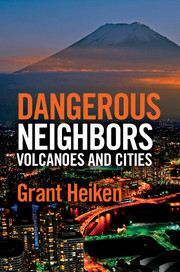Book contents
- Frontmatter
- Contents
- Preface
- Miscellaneous Frontmatter
- Introduction – dangerous neighbors: volcanoes near cities
- 1 Too many people and too many volcanoes – Naples, Italy
- 2 A full menu of volcanic hazards – Mexico City
- 3 “Like dangerous, yet undeniably beautiful women” – Guagua Pichincha and Cotopaxi volcanoes near Quito, Ecuador
- 4 Dangerous neighbors, but some bring gifts – Manila megacity, Philippines
- 5 “It’s part of the culture. Live with it!” – cities in Japan
- 6 Volcanic and proud of it – Auckland, New Zealand
- 7 Coffee, software, aircraft, and volcanic mudflows – Seattle, Tacoma, and Portland, USA
- 8 A tale of two cities – Akrotiri (island of Santorini, Greece) and Plymouth (island of Montserrat, Caribbean)
- 9 The dangerous neighbor is restless – how should a city respond?
- Recommendations for further reading
- Acknowledgements
- Index
2 - A full menu of volcanic hazards – Mexico City
Published online by Cambridge University Press: 05 October 2013
- Frontmatter
- Contents
- Preface
- Miscellaneous Frontmatter
- Introduction – dangerous neighbors: volcanoes near cities
- 1 Too many people and too many volcanoes – Naples, Italy
- 2 A full menu of volcanic hazards – Mexico City
- 3 “Like dangerous, yet undeniably beautiful women” – Guagua Pichincha and Cotopaxi volcanoes near Quito, Ecuador
- 4 Dangerous neighbors, but some bring gifts – Manila megacity, Philippines
- 5 “It’s part of the culture. Live with it!” – cities in Japan
- 6 Volcanic and proud of it – Auckland, New Zealand
- 7 Coffee, software, aircraft, and volcanic mudflows – Seattle, Tacoma, and Portland, USA
- 8 A tale of two cities – Akrotiri (island of Santorini, Greece) and Plymouth (island of Montserrat, Caribbean)
- 9 The dangerous neighbor is restless – how should a city respond?
- Recommendations for further reading
- Acknowledgements
- Index
Summary
In late June of 1997 an unfortunate concordance of events gave the residents of Mexico City a shock. An explosive eruption of their neighbor Popocatépetl Volcano, coupled with wind from the southeast, spread a thin layer of grey ash across the city. In rural areas, such an event certainly would be noticed but would not create the situation reported dramatically by the media (“Mexico City Fends off Volcanic Ash”). Ash fall in a megacity becomes a far more significant story. People on their way to work covered their faces and those without a hat or umbrella combed the ash out of their hair: what a nuisance! Dusty ash infiltrated machinery and caused excessive wear; it clogged filters in air conditioners, and it made the roads dangerously slippery for commuters. The Benito Juárez International Airport, a major Latin American hub with 830 flights per day, was closed because jet aircraft cannot fly in this environment. Within the city, the light dusting of ash was seen as a major annoyance, as cleaning the streets and sidewalks became an arduous task for merchants and street sweepers.
The volcanic ash eruption came from the 17,887-foot summit of Popocatépetl, located 50 miles southeast of Mexico City. This event has reignited the recurring debate over whether or not the volcano poses a serious risk for metropolitan Mexico City and its population of about 20 million. During the last 20,000 years, Popocatépetl (“smoking mountain” in the Nahuatl tongue) has had seven very energetic, explosive eruptions that left thick, widespread volcanic ash deposits. The most recent of these significant eruptions were in 675 and 1095 CE. Volcanologists at the Autonomous National University of Mexico make the point that since many of the town names and geographic features near the volcano use the Nahuatl prefix nex (ash) or xalli (sand-size ash), the debate is merely academic. Recent and ongoing activity, which began in September 1994, has led to at least one evacuation of 50,000 people from villages on Popocatépetl’s slopes as well as the constant state of alert established that year by Centro Nacional de Prevención de Desastres, the government agency responsible for mitigating disasters. There have been 263 recorded eruptive events just since 1999. Fortunately, most ash clouds are dispersed by high-altitude winds toward the east (over the city of Puebla) between November and May and toward the west (over Mexico City) from June to October.
- Type
- Chapter
- Information
- Dangerous Neighbors: Volcanoes and Cities , pp. 43 - 60Publisher: Cambridge University PressPrint publication year: 2013



